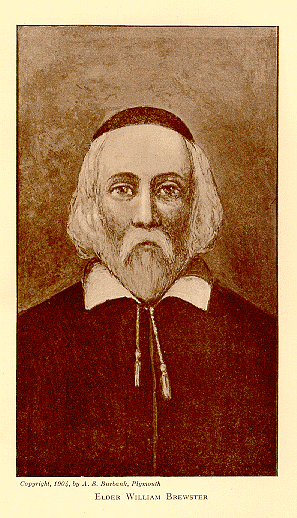
William Brewster (l. 1568-1644 CE) was an elder of the Leiden congregation of separatists (later known as pilgrims) and their spiritual leader while onboard the Mayflower and later after the establishment of the Plymouth Colony. The pastor of the congregation, John Robinson (l. 1576-1625 CE), remained behind in Leiden, the Netherlands with the rest of the congregation when the pilgrims left in 1620 CE requiring Brewster, the next highest authority figure, to assume his responsibilities in the New World.
Brewster was one of the most highly educated members of the congregation after John Robinson, having attended Cambridge (as did Robinson), and also the only one with any political experience as he had served under the diplomat William Davison (l. c. 1541-1608 CE), ambassador for England to the Netherlands and best known for his role in the execution of Mary, Queen of Scots (l. 1542-1587 CE). Following Mary's death, Davidson was arrested and Brewster returned to his hometown of Scrooby, England, where he formed part of a separatist congregation in opposition to the Anglican Church, which regularly persecuted such groups, and so their meetings were held in secret.
In 1607 CE, the congregation was discovered and many of its members fined or otherwise punished; afterwards, they fled to Leiden to avoid further persecution. In 1618 CE, Brewster published a particularly inflammatory work against the Anglican Church, and orders were given for his arrest. The congregation hid him, however, while they arranged plans to travel to North America, and in 1620 CE, he joined them aboard the Mayflower along with his wife, Mary, and their children.
He was one of the signers of the Mayflower Compact and highly regarded by the colonists of Plymouth as their spiritual mentor and guide to the governors. He served the congregation daily as counselor and minister until the arrival of the Puritan pastor Ralph Smith in 1629 CE, after which he continued in a voluntary capacity. His wife, Mary, died in 1627 CE, and he never remarried, continuing his service to the colony until his death in 1644 CE. He is among the best-known of the founders of the Plymouth Colony and is honored in the United States in the present day through monuments and place names.
Early Life & Diplomatic Service
Brewster was born in Scrooby, England, son of William Brewster, Sr. and his wife Mary. He had five siblings and the family was well off financially, William Sr. holding the position of postmaster for the village. Nothing is known of Brewster's early life until 1580 CE when he was enrolled at Cambridge University. Sometime afterwards, he began work as secretary and assistant to William Davison, then Secretary of State. William Bradford (l. 1590-1657 CE), Brewster's fellow church member, friend, and later second governor of the colony, describes their relationship as more that of father and son than master and servant as Davison regularly confided in Brewster and sought his advice.
Davison served as ambassador to the Netherlands, introducing Brewster not only to the more liberal and tolerant Dutch government but the Dutch Reformed Congregationalist Church which flourished there. Brewster, raised an Anglican, was impressed by the simplicity of their services and the independence of each congregation regarding policy and practice. Queen Elizabeth I of England (r. 1558-1603 CE) pulled Davison from the Netherlands and sent him to Scotland on missions to her rival, Mary, Queen of Scots, a number of times, and he was eventually drawn into the queen's plans to have Mary executed.
Not wishing to take responsibility for that, however, Elizabeth blamed Davison after the fact for disobeying her instructions to delay the execution, and he was stripped of his title and imprisoned in early 1587 CE. What Brewster did at this time is unknown, but by 1590 CE he was back in Scrooby and had taken over from his father as postmaster.
Scrooby Congregation & Leiden
After his experiences in the Netherlands with the Dutch Reformed Church (and most likely even before), Brewster became disenchanted with the Anglican faith. A former Anglican priest named Robert Browne (l. 1550-1633 CE) had repudiated the Church as unbiblical and corrupt, founding a movement whose adherents were known as Brownists who differed from other dissenters (referred to derisively by Anglicans as Puritans for their avowed efforts in purifying the Church) in that they believed the Church was beyond saving and one's only option as a follower of Christ was to establish their own, biblically-based, congregations. Interpreting the Bible as the literal word of God and a handbook for life, they took the line from II Corinthians 6:17 – “Come out from among them and be ye separate” – as an injunction to leave the Anglican Church and form their own; these people became known as separatists.
In Scrooby, a separatist congregation had formed which hosted guest pastors (as they lacked their own) among whom was the itinerant Brownist preacher Richard Clyfton (d. 1616 CE) who inspired Brewster to reach out to others to join, offering his own home for meetings in spite of the danger this posed from the Anglican Church whose agents regularly sought out and persecuted such groups. Brewster was married to Mary (maiden name and origin unknown) c. 1592 CE, and the couple both embraced separatism and made their home the center of the congregation's spiritual life. Around 1606 CE, John Robinson joined and became the congregation's pastor.
In 1607 CE, the group was discovered and many of its members fined or imprisoned. William Bradford, who had by this time joined the group and befriended Brewster was among the ones fined. The congregation understood they needed to leave, Brewster suggested they relocate to the Netherlands, and once agreed on by all, he made the arrangements for travel. After two failed attempts (one of which ended when they were betrayed by the Anglican captain of the ship and more of them were arrested), they escaped from England and settled first in Amsterdam and then at Leiden.
Brewster, Mary, and the others purchased or rented homes and settled into their new lives, but as foreigners in a country where jobs were controlled by guilds, they could only find the most menial work. Most of the congregation had been farmers and were now reduced to industrial work in an urban environment, called to and dismissed from work by bells. Brewster found employment at the local university teaching English and there met the gentleman, intellectual, and fellow faculty member Thomas Brewer who shared Brewster's religious vision.
Pilgrim Press & Orders for Arrest
Anti-Anglican literature, of any kind, was banned in England, and its composition and dissemination punishable by fines, imprisonment, torture, and even execution. Brewster's later fellow congregant, Robert Cushman (l. 1577-1625 CE), had been arrested three times between 1603-1606 CE for distributing “libelous literature” critical of the Church, and others had suffered worse punishments. The members of Robinson's congregation, however, especially Robinson and Brewster, felt they were called to speak the truth regarding what they saw as the corruption of the Church, no matter the consequences, and wrote tracts and pamphlets while in Leiden along these lines.
Brewster and Brewer set up a printing press in Brewster's house which, in order to keep its location secret, he had listed with two different addresses; Brewster's mailing address was the front of the house and mail for the press (later known as Pilgrim Press) was delivered to the back, which let out onto another street. At first, they published Anti-Anglican works in Dutch and Latin, but Brewster felt they needed to bring their message boldly to the people of England and so seems to have contacted a young apprentice printer in London, Edward Winslow (l. 1595-1655 CE), for help in this. Instead, Winslow – who had also come to distrust and separate himself from the Church – came to Leiden in 1617 CE to work at the press and join Robinson's congregation.
In 1618 CE, the press published Perth Assembly by a Calvinist dissenter, David Calderwood, which attacked James I of England (r. 1603-1625 CE) and his church on a number of points, and through their connections at the Amsterdam ports, Brewster, Brewer, and Winslow had copies of the work packed into shipments of French wine and shipped to Scotland where other separatists distributed it. It was not long before Perth Assembly came to the attention of Anglican authorities who issued orders for the arrest of Brewster and Brewer.
Brewster was hidden by the congregation and may have even fled back to England once agents began searching for him in the Netherlands while Brewer was arrested and taken to England to be interrogated by the king. Brewer feigned ignorance of the publication, promised he would find this Brewster fellow, and was then supposed to be sent back to Leiden at the king's expense. James I refused to pay, however, and so Brewer remained in England among friends, avoiding notice, for the next few years until the incident was forgotten.
Prior to these troubles, the Leiden congregation had already determined they needed to relocate. They were barely able to make a living in Leiden, and, more concerning, they felt their children were losing their English heritage and assimilating into Dutch traditions and culture. Brewster became the most vocal in advocating for relocation and establishing their own colony in North America. As the most political savvy among them, he was selected to negotiate with the businessmen and bankers of London to finance the voyage, but after he was forced into hiding, this task fell to others, Robert Cushman and John Carver (l. 1584-1621 CE), who were sent to London and Southampton to secure passage and provisions.
Negotiations Without Brewster
England had established its first successful colony in North America at Jamestown in 1607 CE which, though it struggled through its first years just to survive, was thriving by 1618 CE. After much discussion, the separatists decided to found their own colony above Jamestown in Virginia. They approached various financial institutions before they were introduced to the merchant adventurer Thomas Weston (l. 1584 - c. 1647 CE) who agreed to put together a joint stock venture for investors in their expedition.
Cushman dealt directly with Weston in London while Carver worked out practical matters at Southampton and relayed messages to the congregation at Leiden. The initial deal with Weston stipulated that he would provide them with a cargo ship, crew, and provisions – the congregation had already purchased (or had purchased for them) a passenger ship, the Speedwell – and they would agree to work for his investors four days a week to turn a profit, leaving them two days a week for themselves and a day of rest for the sabbath.
As the time drew closer for departure, however, Weston revised the deal. Believing the separatists were too naïve and inexperienced to make the colony a success, Weston hired some people, and invited others, to join the expedition. These people, whom the separatists would later refer to as Strangers (those not of their faith), were all Anglicans who had no interest in leaving England for anything like religious freedom and were only looking for a new start to make their fortune. Weston further stipulated that the colonists would now work for the company six days a week in order to turn a profit and pay back investors more quickly, and these revisions were agreed to by Cushman without consulting the congregation.
In July of 1620 CE, the Speedwell sailed from the port of Delfthaven, Netherlands to meet the Mayflower (and the Strangers and others) at Southampton. Once they arrived, they found out about the new conditions and refused to honor them, causing a rift with Weston who abandoned them (at least momentarily) to their fate. The separatists then had to sell off a number of provisions to pay off debts in order to clear the port and, though they rejected the stipulation regarding work days, could do nothing about the Strangers who would now travel with them. Bradford later criticizes Cushman for this and regrets that Brewster was unable to handle negotiations.
Brewster was reunited with the others at this point and took a place with his family aboard the Speedwell. The Speedwell was to take most of the congregation, presided over as ship's governor by John Carver, while the Mayflower would carry the provisions, most of the Strangers, and the passengers' personal items, which included anything that had not been sold to help finance the trip including desks, chests, and clothing, and was governed by a man hired by Weston, one Christopher Martin (l. c. 1582 - winter of 1620/1621 CE), whose arrogance and disdainful attitude toward the separatists caused tensions to rise almost immediately.
Mayflower Voyage & Compact
The two ships left together in July, but the Speedwell began leaking, and they had to return to land twice for repairs before it was finally abandoned. A number of the passengers from the Speedwell, including Brewster and his family, then boarded the Mayflower which left Plymouth, England on 6 September 1620 CE. The Strangers and Saints (as the congregation called itself) were closely pressed together on the 'tween deck for the next two months as they crossed the Atlantic Ocean on rough seas. Almost everyone, Bradford reports, suffered seasickness, and there was little to no privacy, increasing the tensions which were made worse by Martin and seem to have been addressed and calmed by Carver and Brewster.
Upon sighting land on 9 November 1620 CE, they found they had been blown far off course and were off Cape Cod, far from their destination. At this point, some of the Strangers noted that there was no need now to pay any attention to their patent because it did not apply in this land, only in Virginia, and once ashore every man should be able to live as he pleased without regard for others.
The separatists recognized that none of them would survive if they did not all work together toward a common goal and so the document known as the Mayflower Compact was composed, establishing a democratic form of government for the colony, which was signed by 41 of the men on board, including Brewster, on 11 November 1620 CE. Carver was elected first governor of the colony, the ship dropped anchor, and exploratory missions were launched to find a place to build the settlement.
Conclusion
Between 11 November and 21 December 1620 CE, the small boats of the Mayflower explored the shores, finally settling on an abandoned village of the native Pawtuxet tribe as the site for Plymouth Colony. Brewster led the passengers in prayer, asking for God's blessing on their work, and they began to build the first shelters. Since they had been planning on arriving in North America in late summer, and close to an established colony should they need help, they were unprepared for the harsh New England winter, and between December 1620 and March 1621 CE, 50% of the passengers and crew died.
The new colony would not have survived if not for the intervention of the Native Americans of the region who were first represented by Samoset (also known as Somerset, l. c. 1590-1653 CE) who introduced them to the chief of the Wampanoag Confederacy, Ousamequin (better known as Massasoit, l. c. 1581-1661 CE) and Tisquantum (better known as Squanto, l. c. 1585-1622 CE). Squanto was fluent in English, having been kidnapped to be sold into slavery years before, and served as the colonists' translator as well as teaching them how to plant crops, hunt, and fish.
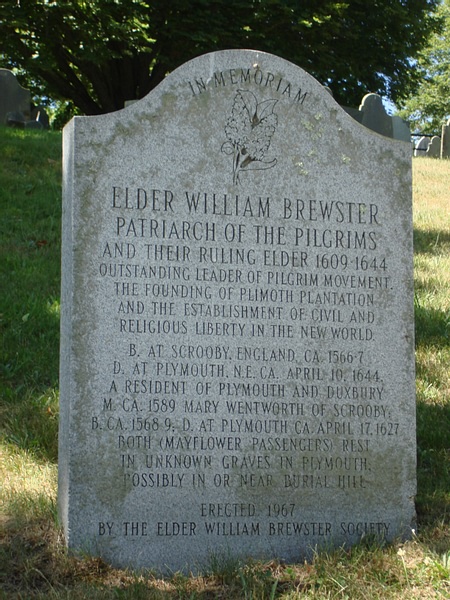
Once the settlement was established, Brewster continued to serve as its spiritual leader for the next nine years until an official separatist pastor, Ralph Smith, arrived to take over. Afterwards, Brewster continued in an unofficial capacity to serve his fellow colonists. He survived his wife and two daughters, never remarrying, and died of natural causes in 1644 CE. Bradford eulogizes him warmly in Of Plymouth Plantation as “wise and discreet and well-spoken, having a grave and deliberate utterance, with a very cheerful spirit” (Book II. ch. 23). Although he does not feature in the better-known episodes of exploration or interactions with the Native Americans, Brewster played a significant role in the establishment of Plymouth Colony, not only by encouraging the voyage and its establishment in the first place but also as the spiritual center of the community after it was founded.
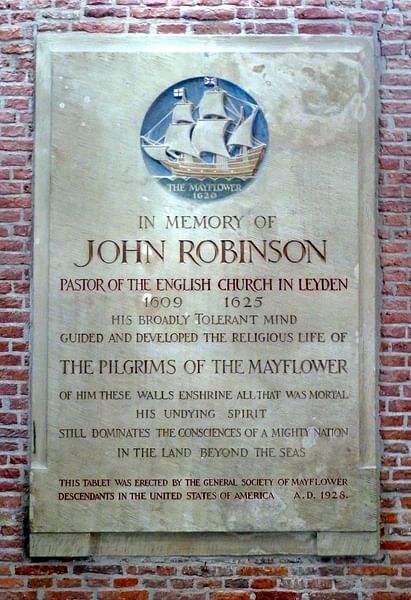
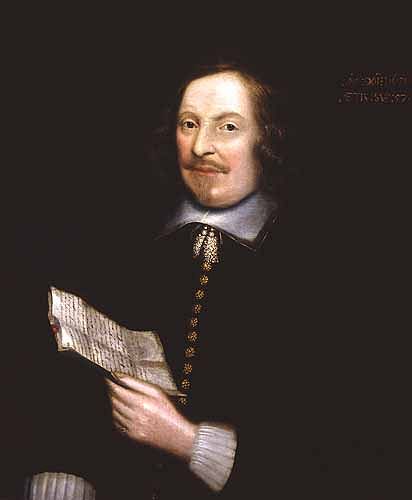
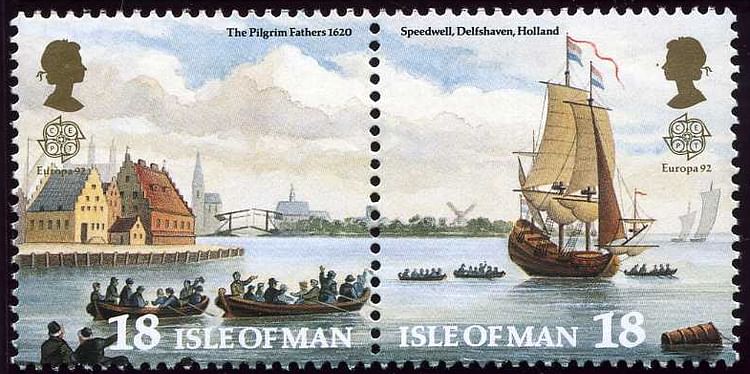

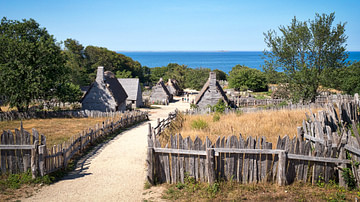
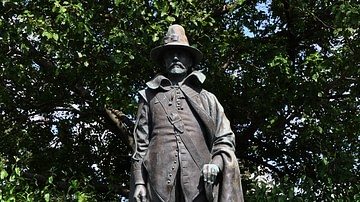
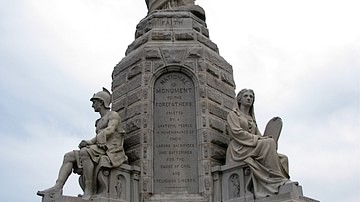

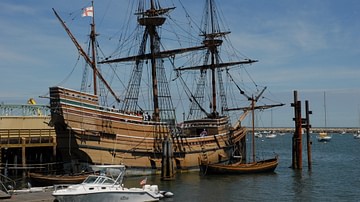




![[Mayflower: A Story of Courage, Community, and War] [By: Philbrick, Nathaniel] [April, 2007]](https://m.media-amazon.com/images/I/51tPkcPE8JL._SL160_.jpg)